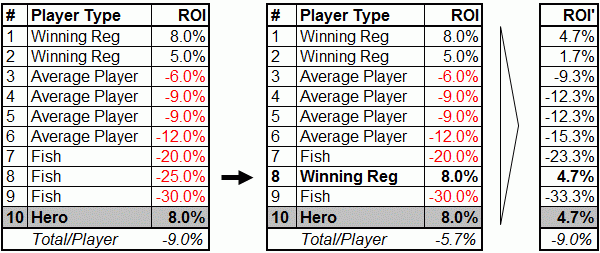Recommended Poker Room
You certainly know that it is better to sit at the table with plenty of fishy opponents instead of winning players. But how much does a regular at your Sit’n Go table decrease your ROI? Our team at TournamentTerminator has developed an example of a mathematical derivation of how much winning players at your table affect your ROI. And the conclusion is obvious: you should spend enough time on table selection, as this is one of the biggest levers to increase your ROI.
Winning Players are Multitabling – Try to Avoid Them With Clever Table Selection
On many poker rooms, SNG tables on higher limits fill up only slowly. If you see in the poker lobby five open SNG tables, filled with 8, 8, 5, 5 and 3 people, then your alarm bells should be ringing. Many players at these tables will be regular players who are multitabling. An inexperienced player will play usually only at one or at two tables. And inexperienced players are usually the fish. Conversely, players who play 4, 6, 8 or even more tables at the same time are usually winning player or “regulars” (regs). And it’s not fun to play against those players, as it will become very difficult to achieve a positive ROI if many regs are sitting at your table.
Example ROI Distribution at a SNG Table
Since poker (not considering rake) is a zero-sum game, is the sum of all ROI must be 0. Considering rake, the average ROI is about -9% per player at a $10 tournament with $1 rake (exactly: -9.09%, 1/11).
Let’s say that we (Hero) are achieving 8% ROI. We now have set up a table with examples of players with our hero (8% ROI) and an average ROI for each player of -9%. The table is made up of two other Regs (8% and 5% ROI), 4 average players who would play break-even if there was no rake (-6% to -12% ROI with rake) and three fishes (-20% to – 30% ROI):

The majority of players must be losing players. And only a few players can beat the rake and achieve a profit. Now, the question is how the expected ROI of the individual players changes if a fish (for example the fish on seat 8 with -25% ROI) is replaced by an additional winning regular (+8% ROI). This simplification is only correct if you assume that the edge of the individual players against each other remains the same.
The sum of the ROIs must remain at -9% per player. Just consider some simple examples from a heads-up Sit’n Go: In a HU game (with 10% rake) is average ROI is -9% / player. This condition is true if for example one player has a ROI of 6% and the other player has a ROI of -24%: one player beats the rake by 15%, and the other loses 15% in addition to the rake.
What happens if two equally good regs (with 5% ROI) play Heads-Up against each other? Well, their long-term return on investment will amount to minus 9%, since they have no edge against each other but still have to pay rake.
And what happens when a player with a 6% ROI plays against a player who just breaks even (0% ROI) and is just able to pay the rake? Both players will become losing players. As the sum of the negative ROIs must add up to -9% per player, a total -18% ROI has to be achieved: 6% + 0% = 6%; 6% – x% = -18% -> x% = 24%. In this simple example, you see that the ROI for each player is expected to fall 12% (24/2). If these two players play against each other for a long time, they will achieve a negative ROI of -6% respectively -12%. Note that stronger player is still 6%-points better than the bad player, but the two players have become losing players.
Influence of Table Selection on ROI in a Sit’n Go
Following the same pattern, you can now customize the above example of a 10handed-SNG. If a reg with +8% ROI instead of a fish with -25% ROI plays at your table, there is a difference of 33% points ROI. In a simplified calculation, this decrease in ROI is evenly spread among the players. So because instead of a fish a winning reg plays the table, the ROI of each player drops by 3.3% points! This means that our hero will achieve a ROI of only 4.7% instead of 8.0%. This could be translated into a monthly profit of just $470 instead of $800 for our hero, which corresponds to a profit reduction of more than 40%.

If, in addition, an additional second regular winning players sits down at the table instead of an average player (+8% ROI instead of -9%), the ROI for our Hero decreases by 5%. This also means that our hero could increase his ROI from 3% to 8% if he just avoids two regs.

Summary SNG Table Selection
This poker strategy article has shown how strong the influence of winning players at the table is on the ROI of other SNG players. With a simple measure – table selection – you can quickly increase your ROI in Sit’n Go tournaments by 5% by avoiding sharks, the strong regular poker players.
Tip: an even simpler way to increase your ROI by 5% is to activate a great bonus. Have a look at our exclusive poker bonus offerings for tournament players now!
888 Poker has one of the easiest to beat player pools. Avoid the sharks on PokerStars, play where the fishes are!
>>Beat the Fish at 888 Poker Now! Get $88 free! <<
 www.
www.
